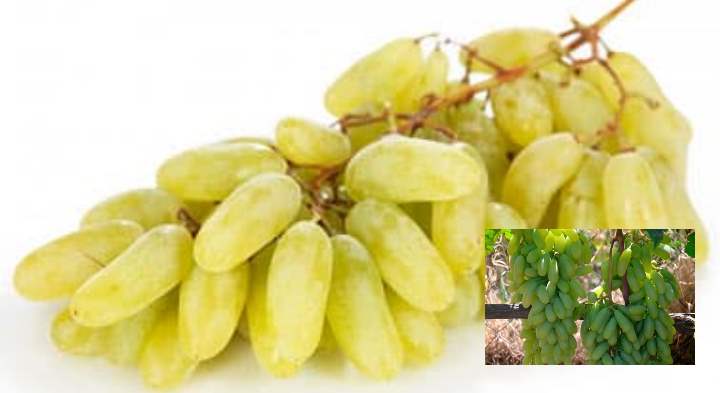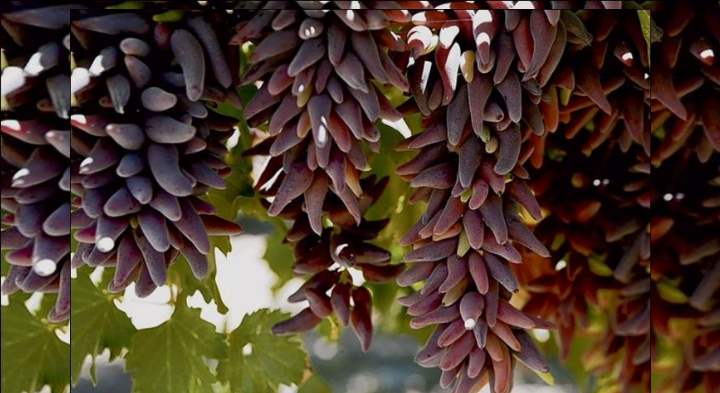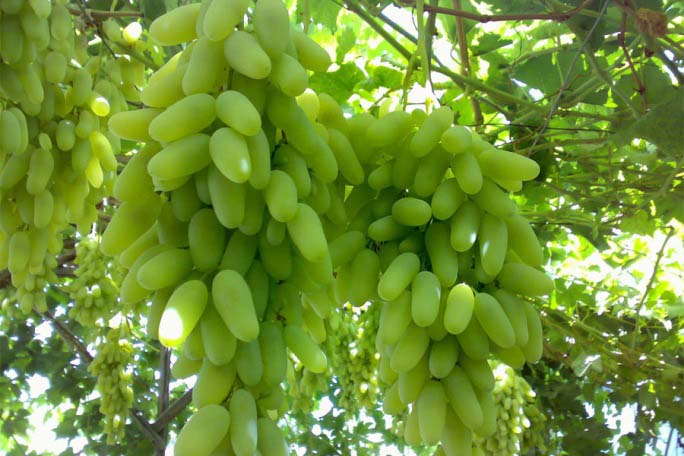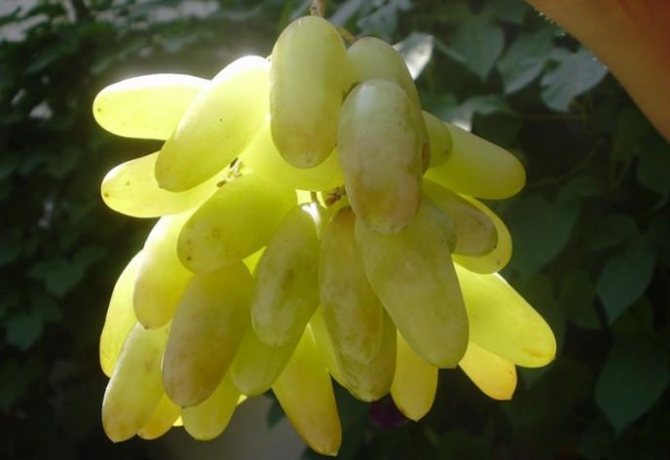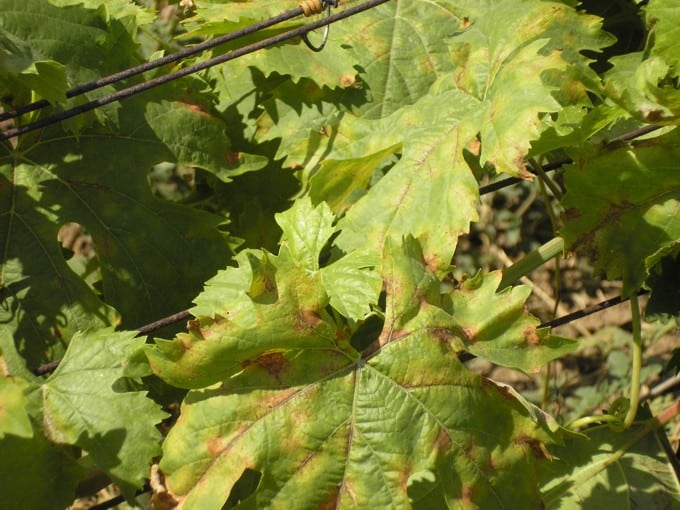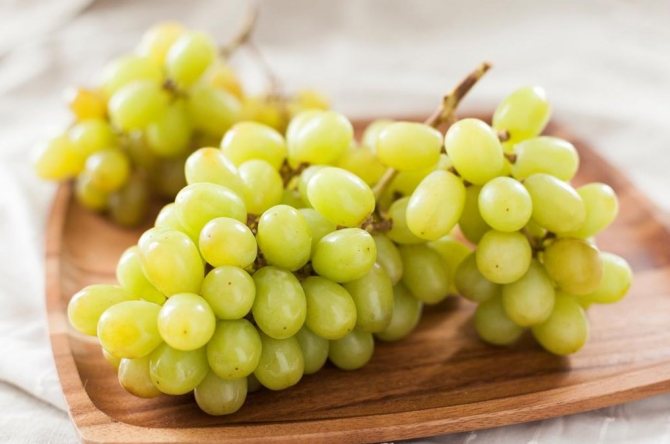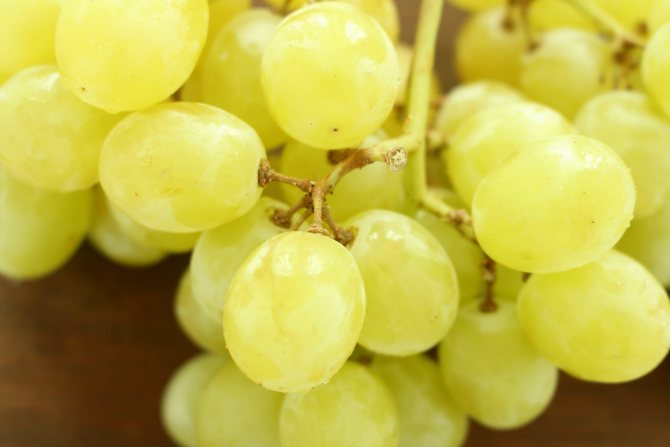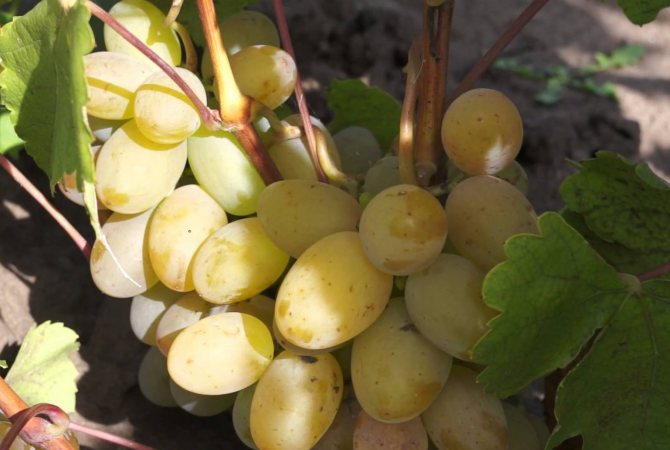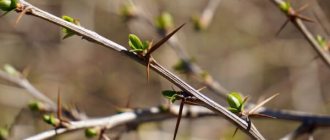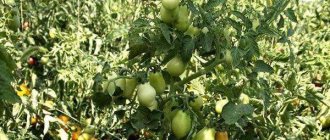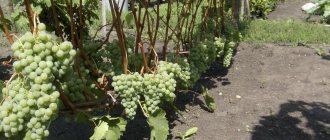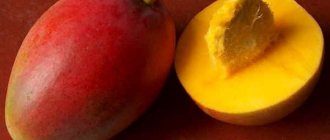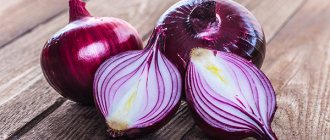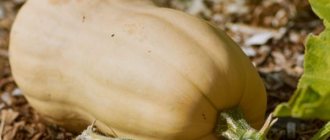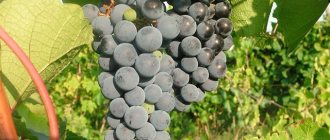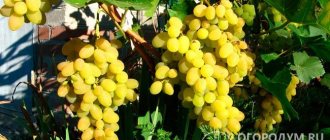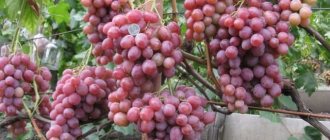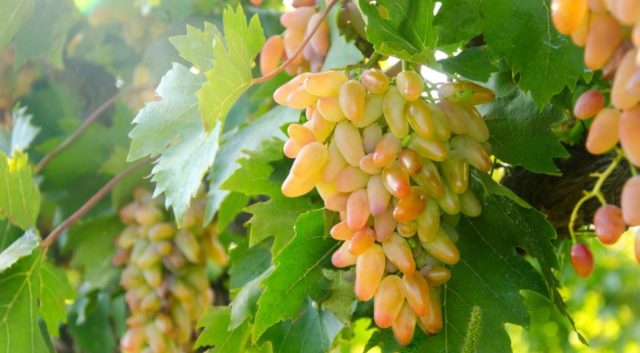
"Ladies fingers" is an elongated table grape variety. Its real name is Husaine Kelin Barmak. He comes from Asian countries. The variety got its name for the thin elongated berries, which sometimes reach the size of the little finger. There are several varieties of "Ladies fingers" they are distinguished by the color of the berries, which are white, pink and black. The most common of them is white-fruited. It is about this variety of the variety that will be discussed in our article.
The history of grape selection "ladies fingers"
Ladies fingers grapes have been growing in Central Asia for several centuries. The variety was bred after germinating wild grape seeds several times.
The Chinese believe that an interesting variety with oblong berries was brought from a place that was located in a river valley called Zarafshan. According to their data, this happened as early as the 1st century AD.
In the middle of the Middle Ages, grapes began to spread across the territory of Uzbekistan, and in 1613 they were first planted in the Astrakhan region. After that, "ladies' fingers" began to slowly develop the Crimean peninsula.
Today grapes "ladies' fingers", the benefits and harms of which are known everywhere, are actively grown in Russia, Ukraine, as well as in Georgia, Uzbekistan, Tajikistan - in those countries where warm climatic conditions prevail. Common varieties of raisins.
What species does it belong to?
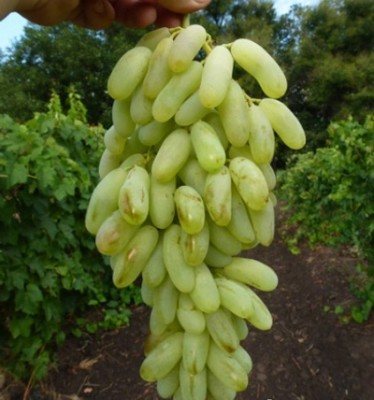

White grapes "Ladies fingers" are rightfully recognized as one of the best table varieties in the world. It used for fresh consumption and making delicious raisins... Grapes belong to the group of Central Asian varieties.
Among the raisins, Karmakod, Kishmish Centenary and Zest are also known.
It gained its popularity due to its excellent taste, excellent presentation and transportability. And the variety got its poetic name because of the oblong shape of the berries.
However, "Ladies Fingers" is a market name. In professional viticulture, this variety is grown under the name "Khusain Belyi"... In Dagestan, it can be found as "Shah-raisin", in Russia - "Bokalny", and in Armenia - Itsaptuk.
Exotic guests from America Black Finger and Witch's Fingers are similar in berry shape.
general description
The people call this grape variety "ladies' fingers". While in official sources it is designated as "Husayne white". The variety has a distinctive feature - the elongated shape of the berries. A bunch that is fully formed can reach 18-50 cm in length and about 25 cm in width. This makes the bunch visually very beautiful and attractive.
The color of the berries can range from yellow-green to yellow-pink. The weight of one piece reaches 7 grams, and a whole branch - 500 grams.
A distinctive feature and advantage of the variety is the absence of seeds.
Where does it grow?
"Ladies' fingers" can be found today in the Caucasus, Ukraine and southern Russia. The plant feels good and bears fruit only in places with a warm climate.
What taste?
The taste of grapes can be characterized as a harmonious balance of acidity and sweetness. Therefore, the variety is filled with an extraordinary taste and smell, which is especially appreciated by lovers of grape berries. When ripe, the taste of acid is slightly lower than that of young fruits.
Despite its sweet taste, the calorie content of ladies' fingers is low.
But it cannot be stored for a long time. Therefore, raisins can be made to preserve its perfect balance of flavors. In this form, the plant will not lose its qualities and will be able to keep for a long time.
How is it useful?
Useful properties of grapes "ladies' fingers" have been known and studied in medicine for a long time. The plant contains a large amount of various minerals and vitamins. Therefore, the fruits will be extremely useful for young children for their healthy and full development.
If you consume 100-200 g of grapes several times a week, then the person's digestive system will noticeably improve, as well as the risk of malignant tumors and the development of heart disease will decrease. The benefits of grapes for women.
Useful properties of grapes
Perhaps there is no person who would not love grapes. In addition to beneficial properties, grapes have a wonderful taste and are a storehouse of substances that our body needs. Grapes contain fiber, ascorbic acid, vitamins B, C, P, potassium. Grapes have only one drawback - high calorie content (from 65 to 85 Kcal per 100 g of product). Therefore, if you follow the figure, you will not be able to eat enough of it.
I have always thought that such warnings were unfounded. How can you gain weight from fruits? But I was convinced of this by the example of a close friend, when she, leaning on sweet fruits, gained seven kilograms in three months. Since then, I have followed the nutritional guidelines for grapes - 200 g per day as fresh berries or 100 g as raisins. And it tastes good for me, it is good for the body, and for the figure without consequences. If you are struggling with extra pounds, pay attention to the article "How to properly lose weight at home, with health benefits?" on the site "Sunny Hands"
... What beneficial properties have nature endowed grapes with?
Grapes are an amazing plant. Grapes have a lot of useful properties. We use almost all of its parts: fruits, leaves, vines. What other plant provides such a wide range of applications? I was unable to answer this question. At the same time, no other culture requires so much knowledge to grow it.
There are about eight thousand grape varieties in the world. The most popular are "Isabella", "Kishmish", "Ladies fingers", "Cardinal", "Victoria". Grapes symbolize well-being, prosperity, abundance. And the ancient Romans considered wine exclusively the drink of the Gods.
What are the beneficial properties of grapes? Why are grapes so highly prized?
This berry is known for its diuretic, laxative, tonic properties. Eating grapes helps to cope with coughs due to the high content of organic acids in grapes. They are irritants to the respiratory tract. As a result, sputum production is relieved and the cough is softened. Grapes also heal sore throats. What other useful properties does it have?
- grapes contain potassium. This element is responsible for the work of the cardiovascular system. In a well-known travel publication I recently came across a note in which it was said that according to the World Health Organization, the French are the least affected by cardiovascular diseases in Europe. Doctors associate a similar fact with the popularity of grapes in this country. The note also noted that the most useful in this regard are dark grapes.The substances they contain, including potassium, reduce the risk of heart disease by 40%. The inclusion of grapes in the daily diet contributes to the resorption of cholesterol plaques, as well as the restoration of the elasticity of the walls of blood vessels. Grapes helps to reduce high blood pressure, eliminates shortness of breath and normalizes the rhythm of heart contractions;
- grapes are rich in resveratrol - a powerful natural antioxidant. It protects the body from thrombophlebitis, sclerosis and malignant tumors. But this element is contained only in dark grapes. Resveratrol is also recommended for women of Balzac age. It prevents the development of osteoporosis, which suffers after 50 years due to a decrease in estrogen levels for more than half of the fairer sex. Resveratrol is also responsible for maintaining the youthfulness of the skin. Like any antioxidant, it stimulates collagen synthesis. For valuable advice on preventing age-related skin changes, see
article "Skin care after 30. (Part 2)" on the portal "Sunny Hands"
;
- grapes contain a lot of organic acids (tartaric, citric, malic, oxalic, salicylic, succinic). They are responsible for the normalization of the acid-base balance in the body and remove uric acid and salts from the body, which has a beneficial effect on the functioning of the kidneys;
- grapes contain B vitamins. Their daily requirement is contained in one glass of grape juice. B vitamins improve the condition of hair, skin and nails, and also have a positive effect on the nervous system, memory, sleep. These vitamins are responsible for the "production" of red blood cells in the body and the regeneration of red blood cells;
- a lot of grapes and vitamin C. It is not only responsible for the youthfulness of our skin, but also protects the body from germs and bacteria. It is also a natural antioxidant. Moreover, it is absorbed by the body in the maximum amount and tends to accumulate in it. This process is influenced by another vitamin found in grapes - P.
Grapes contain sodium, iron, magnesium, calcium, essential oils, fructose and glucose, tannin, fiber, pectin. Moreover, the amount of valuable substances in grapes is higher than in other products, which are considered the main suppliers of this element to the body. Iron in grapes, for example, is two and a half times more than in apples, and magnesium in comparison with mineral water ten times. It is recommended to eat grapes separately from other foods, one to two hours after eating, and be sure to rinse your mouth with water. The fact is that organic acids and sugars, which are contained in grapes, negatively affect the condition of the teeth, provoking the development of caries.
The grapes should be eaten with their skins. It is it that contains the maximum amount of nutrients. Grape seeds are of great value. They contain polyphenols - substances that can bind free radicals. They are the culprits in skin aging and cancer. Grape seeds are used for the production of oils and extracts, as well as supplements are made on their basis.
Doctors recommend that people with kidney, liver, bronchial diseases include grapes in their diet every day. Grapes are useful in the treatment of anemia, gout, chronic hepatitis. It should be used with caution by those who suffer from diabetes mellitus, chronic colitis, stomach ulcers, esophagus and intestines.
With love for the body
The beneficial properties of grapes are manifested not only when they are eaten. Grapes have long established themselves as an excellent cosmetic product. Modern manufacturers produce preparations containing red grape seed extract. As I wrote above, they contain natural antioxidants that prolong the youthfulness of the skin.
Try grape-based masks at home. They improve complexion and skin condition. THESE TIPS will also be helpful. on the portal "Sunny Hands"
... Make a mask like this. It is recommended for all skin types. Due to the fact that grapes contain a lot of organic acids, with the help of this mask you will carry out a kind of peeling. Cut a few berries in half and place them on your face with the flesh side down. Lie down for 15 minutes.
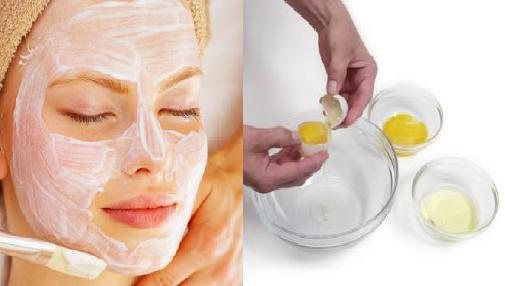

For sensitive skin, such a mask is suitable: take one teaspoon of cottage cheese and honey, rub thoroughly. Add two teaspoons of grape juice to this gruel, stir. Apply the mixture to your face for 15 minutes.
Do you have oily skin? Try the following recipe. You will need one egg, half a teaspoon of vegetable oil and two teaspoons of grape juice. Separate the white from the yolk and beat, mix with butter and juice. Keep on the face for 20 minutes. This mask tightens pores and whitens the skin.
Dry skin will benefit from a mask made from grape juice and honey. Mix them in equal proportions, then soak cheesecloth in this mixture and apply to your face. Leave it on for 15-20 minutes.
Pamper your skin with a grape bath. You will need a glass of grape juice, a tablespoon of honey, and half a glass of cream. Mix everything and pour into the bath. The water temperature should not be higher than 38 ° С.
Grapes are a storehouse of nutrients for hair. Take one bunch of seedless grapes and chop it. Squeeze juice from the resulting mass (through cheesecloth). Add one tablespoon each of flaxseed oil and honey. Stir. Keep on hair for half an hour. Apply the mask to dry hair before washing.
To strengthen the hair, rub in freshly squeezed grape juice half an hour before washing. Do the course for a month, two procedures per week.
Is your hair lacking in shine? Again grapes will help out. Combine three tablespoons of crushed seedless grapes with two yolks. Apply to hair and roots for 20 minutes.
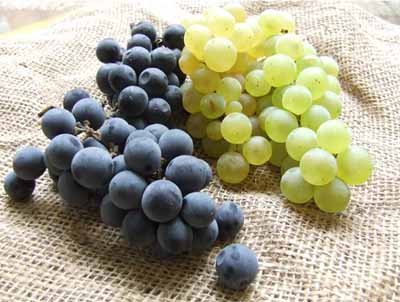

How to buy ripe grapes?
When choosing grapes, make sure that the berries are not damaged. Pigmentation on them is not at all an indicator of poor quality. There is a whitish bloom on the skin of fresh berries. Dark grapes last longer than light grapes, as do varieties with thick skin and firm flesh.
To select ripe grapes, try the berries from the bottom of the bunch, although we usually do the opposite. They sing first at the top and only then at the bottom. Therefore, the top berries may already be ripe, juicy, and the bottom green. Most of the delicious varieties have a small berry that seems outwardly unattractive to us. Give preference to these grapes.
I have a friend who grows grapes. He likes to say that you can't buy good grapes in stores. To the question: "Where can I get it then?", He invariably answers that you need to breed your own. If you are thinking about something to do for your soul, perhaps this advice will be useful to you. And for health as well!
Article protected by copyright and related rights. When using and reprinting the material, an active link to the women's site is required! Best regards, Oksana Chistyakova.
Appearance
The main distinguishing feature of the variety is its large and beautiful bunches, which consist of elongated fruits. Young berries are yellow-green, while more mature berries are yellow-pink. The length of each "finger" reaches about 4-5 cm, while the weight is 7 g. In addition, a specific bloom will help to determine the variety, which covers each berry, which contains a large amount of minerals, vitamins and other useful elements.
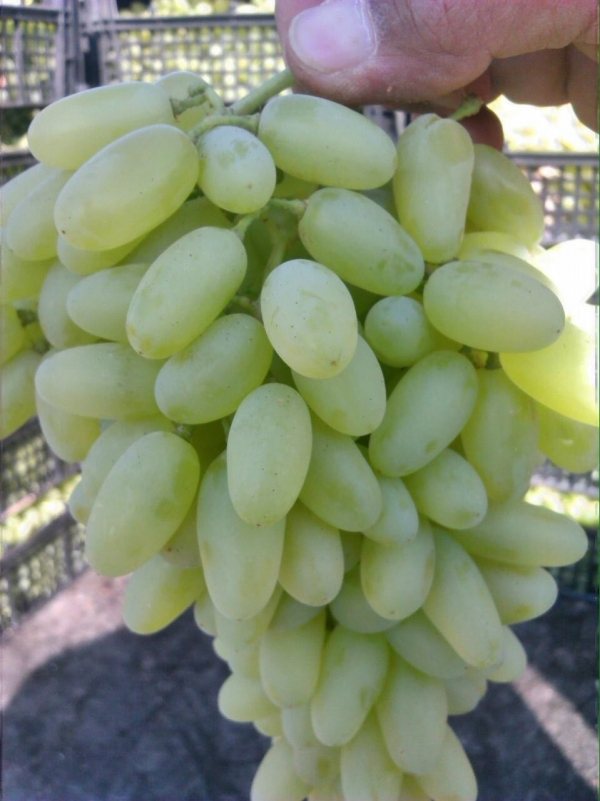

It looks like a ripe bunch of grapes "Ladies fingers"
The leaves of the plant are of medium size and are light green in color.They usually sag slightly at the edges, which leads to fractures and cracks.
The plant forms a vigorous bush, on which large and beautiful bunches are formed on all sides during the ripening period of the crop. One weighs 500 grams or more.
We analyze the rules and secrets of planting ‘Ladies fingers’
So you've decided to become a winegrower. Or do you just love the sight of grapes in your country house or garden. If you have chosen the ‘Ladies fingers’ variety for planting, you must remember the rules for planting and care:
- It is necessary to plant the plant in sufficiently fertile soil. If you do not have the opportunity to plant a plant in fertile soil, you must provide it with all the necessary minerals and useful fertilizers.
- Growing should take place in a sunny location, the plant needs a constant flow of heat. The grapes should not be in the shade of other plants.
The plant must be protected from direct strong wind currents. It is best to choose the southwest side of the site for planting, which will be covered on the north side by fences or buildings.
- The depth of the groundwater should not be too shallow or too deep. A depth of 2.6 to 3.2 meters is best. If it is not possible to provide this parameter, it is necessary to resort to additional measures, such as creating a drainage system.
- The planting time of 'Ladies' fingers' depends on what kind of seedlings you have at your disposal. If you are planting seedlings that are in a dormant state, then it is better to choose March-April or the second half of October for planting. If you are planting seedlings that already have green shoots and leaves, it is best to choose the end of May - early June.
Planting secrets for each gardener may be different. But there are those that are the most common and will work for everyone.
Remember:
- When planting, fertilizers should not be spared (preference should be given to fertilizers that contain a large amount of nitrogen). This will allow the young bush to root faster in a new place and develop successfully in the future.
- Dig a deep hole for your seedling - at least 85 cm.
- After you add fertilizer to the pit, cover it with a layer of soil. After that, the pit must be left alone for several days.
Make sure that the roots of the seedling are free from defects, well developed, and they are white. Healthy roots are the key to the successful development of the entire bush.
- Before planting, it is worth soaking the bush in water. It can be kept in water for about two days.
- It is necessary to plant a young bush in a hole with extreme caution.
- After filling half of the soil, it is necessary to water abundantly with water. Better if it is water with fertilizers.
- After digging the whole hole, it is necessary to water it again.
- It is necessary to drive a peg next to the seedling without damaging the roots. It is better to immediately tie the peg to the plant and plant with it. Then untie.
Features of the variety
Grapes are table varieties. The main distinguishing feature of the plant is its interesting, moderately sweet and sour taste.
The plant is very difficult to adapt to external conditions, so it cannot grow everywhere. The best wine grapes.
Sustainability
From the description of the grape variety "ladies' fingers" it becomes clear that it can grow only in warm climates. Therefore, the plant will not bear fruit in wet or dry weather.
The plant does not tolerate cold. It will not withstand temperatures below minus 10 degrees. If the plant is grown in places where frost is possible, then it is better to cover it securely in order to prevent death.
Dry summers also pose a problem for this variety. To save the vine, you need to provide the plant with constant watering. It is best to avoid heavy moisture as this will cause the fruit to rot.A similar situation with the harvest will happen in a rainy summer. To save at least part of the harvest, you need to carefully monitor the ripening bunch of grapes and, if rot is detected, quickly eliminate it.
The grape variety "ladies' fingers" during the hot and humid summer can be affected by powdery mildew. If this happens, then up to 80% of the crop may simply be lost. It is quite simple to define a disease by the following signs:
- specific spots of a dirty gray color appear on the vine;
- undertakes a mealy bloom;
- death of affected inflorescences;
- berries dry out and stop growing;
- the smell of rotten fish appears next to the bush.
With frequent fogs, a fungus called mildew forms on the plant. It affects all the greens of the plant. At the same time, the fruits do not visually deteriorate, but acquire a sour taste.
In addition to natural hazards, grapes are very afraid of attack by pests such as:
- phylloxera;
- leaf roll;
- spider mite;
- cicada;
- grape thrips;
- weevil;
- grape aphid.
Wasps can also damage the crop. Insects simply eat away at the flesh of the fruit. During the ripening period, birds also love to eat sweets, which leads to pecked berries and broken bunches.
On the site you will also find a description of the following grape varieties: Amur, Moldova, Victor, Rochefort, Kishmish, Libya, Cardinal, Lydia, Isabella, Arcadia. And what are the benefits of grape seeds, read here. The main properties of black, red and green grapes.
Care
This culture is very capricious, therefore it requires close attention and special care.
The first thing to look for is the optimal conditions for growing grapes. In addition, the plant must be able to properly and timely cut. This is done every spring to form the bush.
Also, the plant needs proper feeding. For normal life, grapes need magnesium, the reserves of which will help to replenish special fertilizers.
During the dry period, the plant requires abundant watering. Around the bush, you need to create a drainage system that will allow excess moisture to escape.
With the onset of the winter period, it is better to cover the culture in order to prevent freezing.
Yield
When optimal conditions are created, the variety will be able to bring up to 40 tons of crops from 1 hectare of land. The ripening period of the white Husaine fruit is considered to be medium or medium late. That is, from the moment of flowering to the ripening of the fruit, it can take about 140-150 days. In warmer climates, this period is reduced to 130 days.
The harvest from the bush begins to be harvested at the 5th year of the plant's life.
Grape care
Tomato Ladies fingers: characteristics and description of the variety
The best time to start a new vineyard is spring.
Important! You should not rush to planting seedlings. Grapes are a thermophilic crop and will grow poorly even at low positive temperatures.
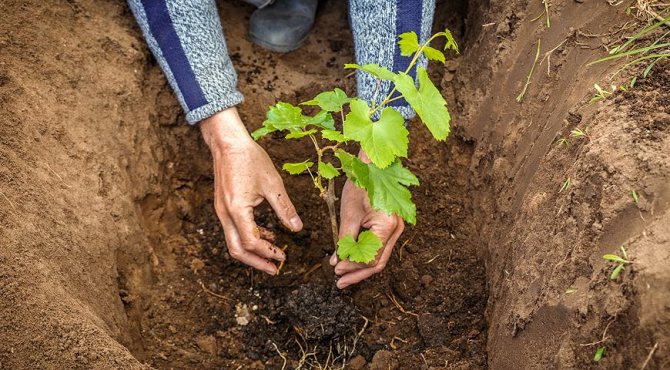

Planting grapes
Saplings should be planted when the air temperature in the daytime will exceed 20 degrees Celsius, and at night it will not drop below + 8 + 10 degrees. Before planting, trenches must be prepared in advance. They are dug to a depth of 70-80 centimeters, and up to 1 meter wide. Grapes grow best on sandy loam and light soil types. In no case should a plot be laid on marshy and saline soils. It is also worth making sure that there are no surface groundwater on the site, otherwise the vines will grow poorly, or they may even die. The place for the future vineyard should be sunny and well ventilated. The southern slopes and hills are best suited.
If the soil in the area is heavy and poor, it is recommended to fertilize it. For each square meter of land, you need to add 1-2 buckets of humus or compost. Mineral fertilizers should also be applied. For 1 square meter, 50 grams of urea or nitrate and the same amount of potash and phosphorus fertilizers are applied.All this will provide nutrition for young plants in the first 2-3 years after planting.
Grapes do not like a lot of water, however, in the first years after planting, young seedlings need abundant irrigation. Plants should be watered frequently in the first 2-3 years - once a week. Watering rate - 2 buckets of water per 1 bush.
Note! During flowering (about 2 weeks), the vineyard should never be watered.
From the fourth year on, watering in the vineyard is reduced. In hot weather, it will be enough to water it once every two weeks, and in cool weather - even once a month. At the same time, in the third or fourth year, the vineyard already needs to be fed. Fertilizers should preferably be given three times throughout the season. The first time the plants are fed a week before flowering. In this case, urea can be used as a top dressing at the rate of 1 tablespoon per 10 liters of water. If urea is not available, it can be replaced with ammonium nitrate, this fertilizer already needs two tablespoons per 10 liters of water.
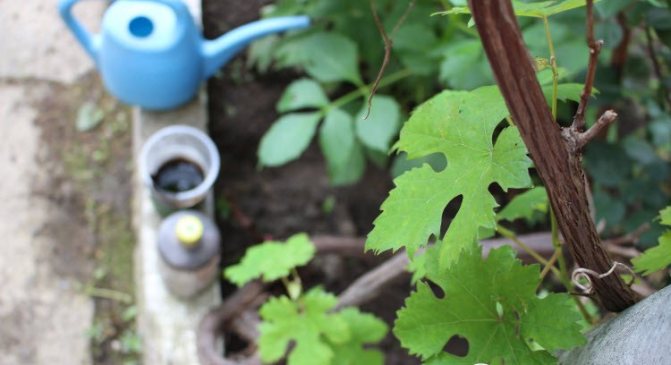

Top dressing of grapes
The second time the grape bushes are fed a week after flowering. At this time, the active formation of berries is taking place. This time they are also fed with urea or saltpeter. The third time feeding is done in August. At this time, the vineyard begins to prepare for winter, for this he really needs phosphorus and potash fertilizers. Mulching is also useful - mulch will not only retain moisture, but also prevent weeds from growing.
Throughout the growing season, grapes need to be shaped and pruned. The vines are tied to trellises, the stepsons are obligatory cut out.
Additional Information! The stepchildren need to be cut, otherwise they will take food from the fruiting vines, which will ultimately affect the harvest.
Vineyards start pruning, as a rule, after the first light freezing. 2-3 new vines are left on each arm. Shoots must be strong and ripe. Vines are also pruned, leaving 7-9 buds on each. You should not rush to shelter the grape bushes, in warm weather the bushes under the shelter will begin to grind. It is best to cover the grapes for the winter, when small subzero temperatures (-2-4 degrees) are established at night, and during the day the thermometer will not rise above + 8 + 10 degrees. But with the opening of the bushes in the spring, it is better to postpone. Even a slight spring frost can kill the buds. Therefore, it is worth starting to open a vineyard only when the threat of frost has completely passed.
Benefits from use
Ladies fingers grapes have useful and harmful properties, like any other fruit or vegetable. Therefore, before use, it is worth familiarizing yourself with all sides of the plant.
The positive properties of this grape variety include:
- The presence of biologically active substances in the composition. Including acids and vitamins.
- The presence of potassium, which minimizes the risk of developing heart and vascular diseases.
- Reducing puffiness.
- Better sleep.
The main consumer advantage of grapes is the absence of seeds in the berries, which makes the process of consumption simple and convenient.
Advantages and disadvantages
Despite the existing shortcomings, "White Husaine" has been the most popular variety for several centuries. For its gorgeous, sweet, crunchy berries, gardeners are willing to put up with the challenges of growing it.
- high taste characteristics;
- spectacular appearance of bunches;
- lack of seeds;
- the possibility of making raisins;
- high productivity;
- self-pollination;
- good transportability;
- clusters keep well on the vine.
- Low frost resistance - difficult to grow in temperate climates. Shelter for the winter is necessary even in the southern regions of the Russian Federation.
- Berries are not suitable for long storage.
- Low resistance to diseases, it is attacked by parasitic insects.
- Low early maturity.
- Demanding to growing conditions - climate, care, etc. For the berries to be sweet, the variety needs a lot of heat and sun.
Calorie content per 100 grams
In order to eat the plant without harming the figure, many women want to know how many calories are in grapes for ladies' fingers. It contains a large amount of carbohydrates with a relatively low calorie content. The ratio of proteins-fats-carbohydrates is 0.6-0.2-16.8 grams.
The calorie content of grapes ladies' fingers per 100 grams is 60 kcal. When using it during a diet, it is worth remembering that the fruits stimulate the appetite. You can read about the calorie content of mango here.
How to deal with pests and diseases
It was mentioned above that along with excellent taste and decorative characteristics, "Husseine White" is distinguished by its weak points - extremely low resistance to diseases and harmful insects.
Oidium
- To protect the plant from this disease, you need to perform the following activities:
- In autumn, carefully prune dry and “suspicious vines”;
- Before preparing the bushes for wintering, we cover them and the soil must be treated with iron vitriol;
- In spring and summer, the “Finger” bushes should be regularly sprayed with Bordeaux liquid mixed with colloidal sulfur;
- The introduction of trace elements, potassium and phosphorus into the soil, increases the resistance of plants to diseases;
- The drugs Belitol, Fundozol, recommended for the disease, can be replaced with a solution of colloidal sulfur (10 g per 8 l of water) or potassium permanganate (5 g per bucket of water).
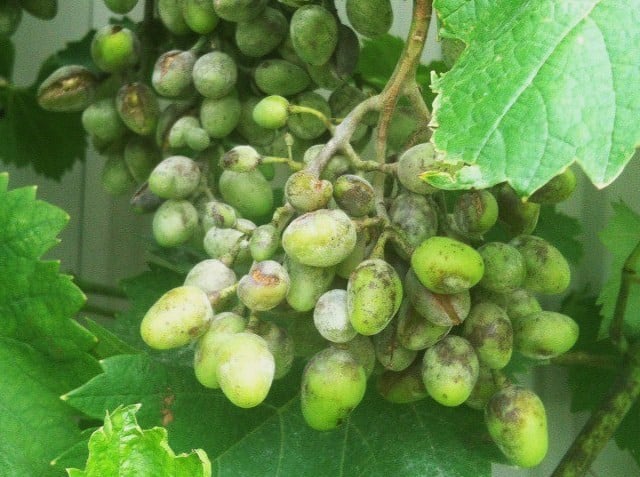

Mildew
In prolonged foggy and rainy weather, the plants are affected by mildew. On the entire green surface of the "Lady's finger" bush, yellow oily spots appear, after fog or rain, covered with a mealy bloom. The disease does not affect mature brushes, but the berries become sour.
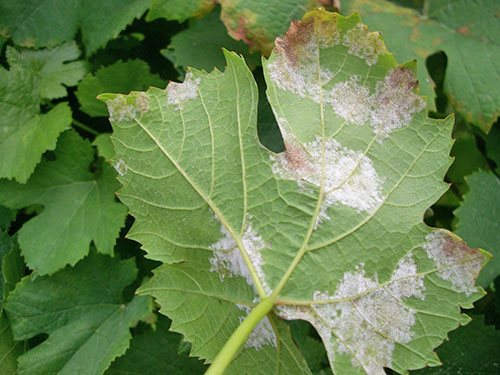

Preparations containing zinc and copper will help to overcome mildew. The best offered by the industry:
- Kuprozan is a contact fungicide with a long-term prophylactic effect;
- Homecin is a fungicide containing copper oxychloride and zineb;
- Cuproxat is a copper-containing fungicide;
- Antracol - used to combat mildew and to prevent many other fungal diseases.
Attention! Treatment of vines with fungicides should be done only in calm weather. Otherwise, you can harm your health, the effectiveness of the operation will be low.
Harmful insects
“Ladies Finger” has a fairly extensive list of its winged, creeping, jumping “admirers”. Here, there is a mining moth, a cotton mite, a flea, and a grape mosquito, etc. You need to deal with them with such chemicals - various insecticides, for example: Mosplan, Sunmayt, Fostak, Caesar, etc.
In addition to using chemistry, you should provide the bushes with nutrients, regularly loosen the soil, prune, and make traps for cicadas.

